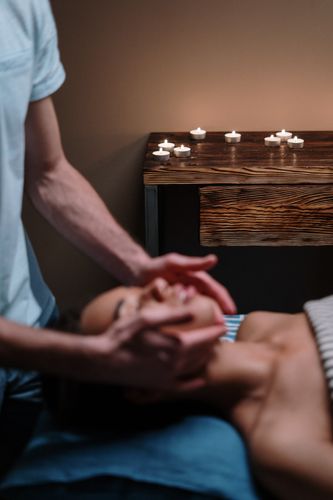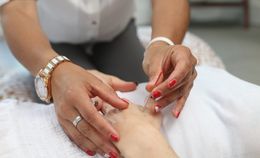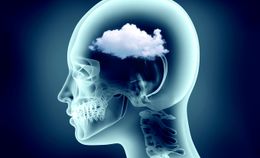Heart palpitations are a feeling your heart is beating too fast, fluttering or skipping a beat. You may feel the sensation in your neck, throat or chest. This can be frightening or bothersome, but is usually not harmful or stressful, and will ease off with time.
They are often caused by anxiety, stress, too much caffeine, alcohol or nicotine. You may also experience palpitations if you are pregnant. In extreme cases, heart palpitations are an indicator of an underlying serious heart condition.
So if you have heart palpitations, you might need to consider Craniosacral Therapy (CST).
Heart Palpitation Statistics
Here is a list of statistics according to the Centers for Disease Control and Prevention:
Heart failure deaths: 5.7 million American adults in the United States have heart failure
2009 deaths: Every 9th death in 2009 was as a result of heart failure.
Death in 5 years: About 50% of people who develop heart failure die within 5 years of diagnosis.
Annual cost: Heart failures are estimated to cost the government a total of $30.7 billion annually.
Number of people with AF: Statistics also showed an estimated 2.7 - 6.1 million people in the U.S suffer from Atrial fibrillation, often called AFib or AF.
7 Types of Heart Palpitations
Here is a list of the seven most common types of heart palpitations:
1. Premature atrial contractions: These are extra beats that originate from the heart's upper chambers, called the atria. They are often harmless and don't require treatment.
2. Premature ventricular contractions (PVCs): These are the most common types. They are the occasional "skipped heartbeat" we feel. They are closely related to nicotine, caffeine or too much stress. They are sometimes caused by electrolyte imbalance or heart disease.
3. Atrial fibrillation: This irregular heart rhythm causes abnormal contraction of the upper chamber of the heart.
4. Paroxysmal supraventricular tachycardia (PSVT): This is a heart rate with a rapid rhythm. It starts from the heart's lower chamber or ventricles. PSVT begins and ends suddenly.
5. Bradyarrhythmias: These are very slow heart rhythms, which may be due to a diseased condition in the heart's electrical system. When this occurs, you may actually feel like you will pass out, or you may actually pass out.
6. Atrial flutter: This is more organized and regular rhythm than atrial fibrillation. It is commonly observed in people with heart disease or the first week after heart surgery.
7. Accessory pathway tachycardias: Your heart rate may be rapid if there is an extra pathway between the heart's lower and upper chambers. You may develop a fast heart rhythm as a result of this. The impulse controlling your heart rhythm travels very quickly, making your heart beat unusually fast.
Others include AV nodal reentrant tachycardia, Ventricular tachycardia (V-tach), Ventricular fibrillation, Long QT syndrome, Sinus node dysfunction, and Heart block.
The Impact of Stress and Craniosacral Therapy on Heart Palpitations
Stress is the chief culprit when it comes to failing health in humans. It negatively impacts the immune system by weakening it, making it vulnerable to all sort of factors. Over time, it disrupts the natural body flow which triggers a vicious cycle of:
Heart palpitations
Depression
Anxiety
Back pain
Neck pain
Insomnia
Digestive problems
Other chronic illnesses
It is imperative to understand how your body is impacted by stress. What's more important is how to handle your stress naturally to stay vibrant and healthy. The good news is, there is always health in our body system. The key is linking to this health in and around us.
Craniosacral Therapy (CST) is a delicate form of bodywork, balancing the fluids, structures, and tissues in the body. CST is hugely beneficial for the body because the craniosacral system is made up of the endocrine and nervous systems which impact bodily functions.
How Craniosacral therapy (CST) May Work for Heart Palpitations
CST is a non-invasive technique that uses therapeutic dialogue, imagery and light touch to connect with a client's subconscious to release and resolve emotional and physical trauma trapped in the body.
The fluctuating fluids in the craniosacral system create a palpable rhythm which is felt throughout the whole body. Any part of the body with trauma, chronic tension or blockages relay dysfunctional movement patterns. These dysfunctional patterns can be resolved by positional release easing of restrictions in and around the craniosacral system. This resolves pain and diseases in the body by boosting the body's innate healing abilities.
As the body releases stored emotions into the conscious mind, patterns of dysfunction are resolved. No one knows better than your "individual inner physician" a term coined by Dr. Upledger; founder of Craniosacral Therapy, CST. It understands what is needed to resolve dysfunction in your body. CST will help you connect and appreciate your inner-self, and you will be amazed at how your heart palpitations, other diseases, and chronic pain will be resolved.
With gentle touches, the therapist feels and observes the cranial rhythm and the pulse of the cerebral fluid - the same way a doctor listens to your heartbeat, body pulse or respiratory system. Through gentle touch, the therapist effects changes in the cerebrospinal flow; thus, resolving blockages, tensions, stress and anomalies in the nervous system.
When the fluctuating fluids in the craniosacral system are enhanced, this reduces the workload on the heart, leading to normalization of your heart palpitations.
The most vital part of the craniosacral therapy is to remain still, as a practitioner delicately listens and follows your body's rhythm to encourage release. Unwinding one area of your body might take anywhere from 5 to 15 minutes. This is a deep and meditative procedure, and you may fall into a state of deep relaxation called Theta Brain-state.
How Many Sessions Might be Needed?
In a case study involving craniosacral therapy given to a sixteen year old female suffering from severe myocardial distress, a total of 7 sessions, with an average length of 60 minutes, was applied. This may also be the number of sessions that you need to help with your type of heart palpitations.
However, the practitioner will determine the number of sessions and the length of time it will take based on verbal intake evaluation and feedback from your body.
What Will Craniosacral Therapy for Heart Palpitations?
The average price per session in the U.S. is $70-$170 for craniosacral therapy. This does not include the possible use of discounts or packages, so be sure to ask your practitioner if they offer any.
For more information, read: How Much Does Craniosacral Therapy Cost?
References :
Atrial Fibrillation Fact Sheet|Data & Statistics | DHDSP|CDC. (n.d.). Retrieved April 16, 2019, from https://www.cdc.gov/heartdisease/atrial_fibrillation.htm
Heart Failure and CranioSacral Therapy - IAHE. (n.d.). Retrieved April 16, 2019, from https://www.iahe.com/docs/articles/Heart_Failure_and_CranioSacral_Therapy.pdf
Heidenreich, P. A., Trogdon, J. G., Khavjou, O. A., Butler, J., Dracup, K., Ezekowitz, M. D., ... Council on Cardiovascular Surgery and Anesthesia, and Interdisciplinary Council on Quality of Care and Outcomes Research. (2011, March 01). Forecasting the future of cardiovascular disease in the United States: A policy statement from the American Heart Association. Retrieved April 16, 2019, from https://www.ncbi.nlm.nih.gov/pubmed/21262990
Robinson, K. J. (2019, March 26). Palpitations. Retrieved April 16, 2019, from https://www.ncbi.nlm.nih.gov/books/NBK436016/
Writing Group Members, Mozaffarian, D., Benjamin, E. J., Go, A. S., Arnett, D. K., Blaha, M. J., ... Stroke Statistics Subcommittee. (2016, January 26). Heart Disease and Stroke Statistics-2016 Update: A Report From the American Heart Association. Retrieved April 16, 2019, from https://www.ncbi.nlm.nih.gov/pubmed/26673558
Www.iahe.com. (n.d.). Retrieved April 16, 2019, from https://www.iahe.com/docs/articles/Article_-_The_Effects_of_Upledger_CranioSacral_Therapy_on_Post_Traumatic_Stress_Disorder_Symptomoatology_in_Vietnam_Combat_Veterans.pdf















